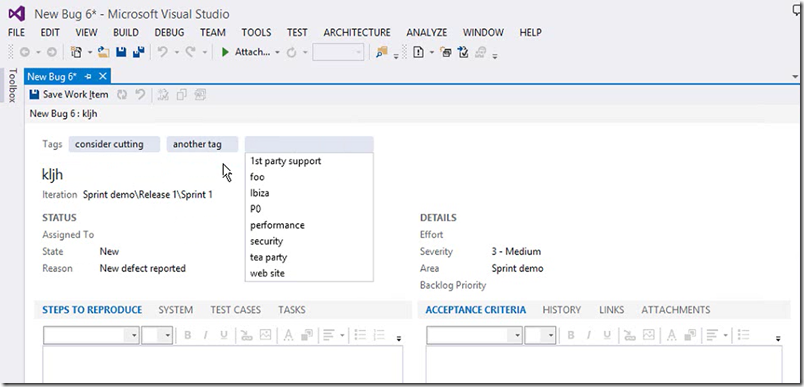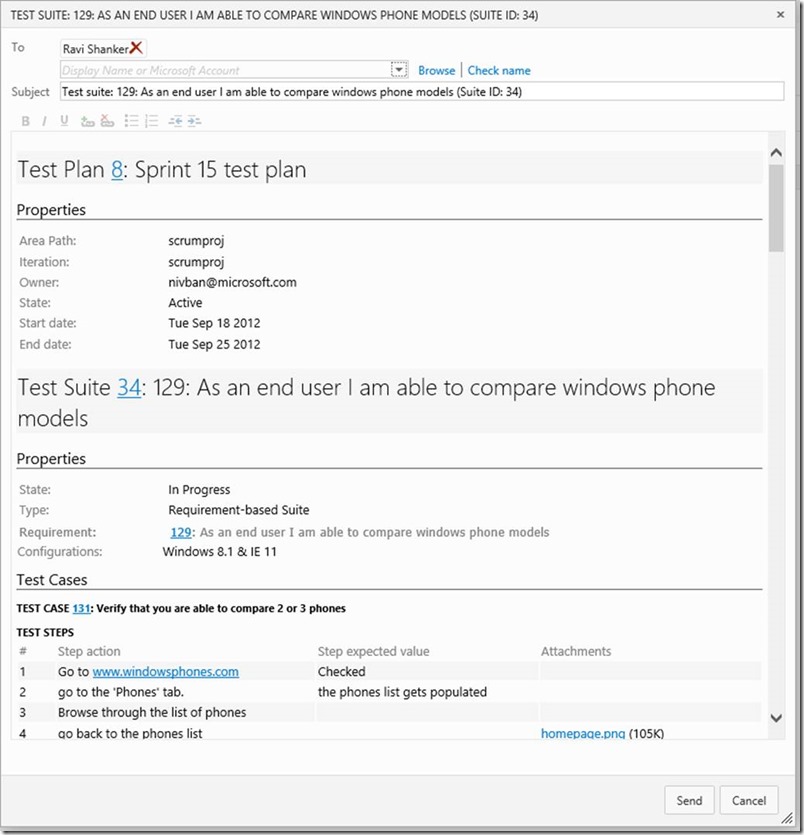Today, fast on the heels of Update 1, we released the first CTP of VS/TFS 2013 Update 2. Although Update 1 was a pretty small release, Update 2 is much larger. This CTP is *not* feature complete and it is *not* “go-live”. It is an opportunity for you to get a peek at some of the things we are planning to release in Update 2. The next CTP (at least of TFS) will be feature complete and “go-live”.
- You can download the CTP here: http://go.microsoft.com/fwlink/?LinkId=390521
- You can read the KB article here: http://go.microsoft.com/fwlink/?LinkId=390522
In this post, I’m going to talk mostly about Application Lifecycle Management (ALM) related improvements coming in Update 2. For the most part, we focused on continuing to “round out” features that have been previously introduced.
Work Item Tagging
In TFS 2012.2, we introduced lightweight work item tagging to easily categorize and find work items. We’ve generally gotten good feedback on the feature but plenty of requests for enhancements. Here’s some things we are adding in this release:
- Query on tags (559 votes on UserVoice) – You can now write and save work item queries containing tag clauses. You simple create a “Tags” contains filter (or does not contain filter). You can combine clauses with “and” and “or” just like any other query clauses. Having it built in like this also means you can create charts filtered by tags (which you couldn’t do before).
- Tags in VS (54 votes on UserVoice) – Previously tags could only be assigned/used within the TFS web UI. With TFS 2013.2 and VS 2013.2, you can now fully use tags within VS. Our Eclipse plugin already supports basic tags on work items and we’ll be looking at adding querying for tags in Eclipse in a future Update.
- Tag permission – Now you can control, with a permission, who can create new tags (if you want to make sure crazy team members don’t pollute your tags with all kinds of random things :)).
- Edit Tags in Excel (30 votes on UserVoice) – Now when you are managing a list of work items in Excel, you can include the tags column, edit it and publish the tags changes back to TFS.
- Object model & REST API support – We added support to access/set tags in the object model and also exposed REST APIs.
Backlog management
We took a bunch of small, but popular requests off our backlog that involved helping you manage your backlog, including:
- Perf improvements – Navigating between the backlog, sprints, etc used to be a post back to the server and was uncomfortably slow. We changed it so it no longer refreshes the whole page and is MUCH faster.
- Non-working days – Starting with Update 2, you can define you’re non-working days (weekends, for most of us) and we’ll exclude them from the burn down calculation so it no longer looks like you are on track when you really aren’t (because you don’t plan to work the weekend :)).
- Configurable start date for cumulative flow diagram – Now you can define what date to start the diagram so that you can spend some time building the plan without the “lack of progress” polluting your chart for the whole project.
Charting
We introduced charting in VS 2013 and we’ve done some work in Update 2 to make charts a little more useful.
- Pin charts to project home page – You can now pin a chart to your project homepage so everyone can see it when they visit your project.
- Customize chart colors – Maybe not a huge deal but very nice. Now you can select what colors you want to use in your charts.
Account and Project home page refresh
We’ve refreshed the layouts of the account and project home pages to try to make them even more useful.
Export Test Plan to HTML
You can now export your test plan to HTML for offline reading/sharing, printing, etc. You can choose the level of detail you want to include in the document.
Release Management
We added a new concept of “Tags” (different than work item tags, just to confuse you) that enables you to tag deployment targets. Tags can be used to treat a set of machines the same. For instance, this allows you to easily deploy the same software to all the machines in a web farm without having to author anything redundantly – just by tagging all the machines the same way.
Git improvements (pre-preview)
These really only get an honorable mention. I include them only because in a previous post, I had mentioned that Git improvements was an area we are focused on. Unfortunately the Git improvements just barely missed the cut-off for Update 2 CTP1 so they aren’t in this CTP but will be in CTP 2. So you won’t find them in this build but expect them soon.
- Annotate – The annotate (aka blame) feature in Visual Studio has been updated to support Git.
- Amend – You can now update your most recent local commit from within VS just like the “git amend” command line allows. You can both go back and fix your commit message and update the files in the commit. Once it has been pushed to TFS, it’s done though.
- Push to multiple remotes – Team Explorer now recognizes multiple Git repos and allow you to select which remote you want to push to/pull from. No more having to drop to the command line for this.
- Revert a commit – You can now easy “rollback” a commit in the event you checked in something that you’ve decided that you really don’t want.
- Progress with cancellation – our long running Git operations now have a good progress experience and have the ability to cancel them if you realize you made a mistake.
Of course, we also fixed quite a few bugs but I’m not going to try to include a full list here.
I’m looking forward to getting a go-live release in your hands so you can give it a go for real but, if you are brave and willing manage through some known issues (see the KB article), check out the CTP and make sure the features work the way you want.
Brian






0 comments
Be the first to start the discussion.